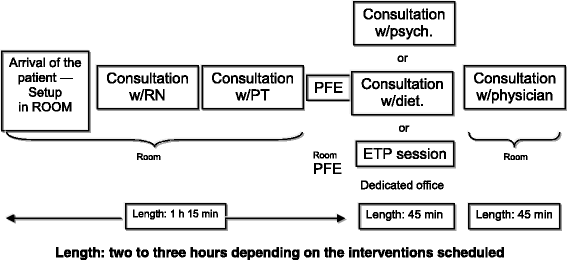Introduction of a collaborative quality improvement program in the French cystic fibrosis network: the PHARE-M initiative
- PMID: 29799384
- PMCID: PMC6225603
- DOI: 10.1186/s13023-017-0745-7
Introduction of a collaborative quality improvement program in the French cystic fibrosis network: the PHARE-M initiative
Abstract
Background: An agreement, signed in 2007 by the 49 French Cystic Fibrosis Centers, included a commitment to participate, within the next 5 years, in a care quality assessment and improvement program (QIP). The objective was to roll out in the French Cystic Fibrosis (CF) care network a QIP adapted from the US program for Accelerating Improvement in Cystic Fibrosis Care developed by The Dartmouth Institute Microsystem Academy (TDIMA) and customized by the US CF Foundation between 2002 and 2013.
Methods: The French national team at the Nantes-Roscoff CF Center of Expertise was trained at TDIMA and visited US CF centers involved in US Learning and Leadership Collaboratives (LLCs). It introduced the PHARE-M QIP in France by transposing the Action Guide and material. A PHARE-M LLC1 including seven centers, underwent two external assessments. Adjustments were made, then a PHARE-M LLC2 was rolled out at seven more centers in two regions. On-site coaching was strengthened. The teams' satisfaction was assessed and further adjustments were made. In 2014, the program sought recognition as a continuing education program for healthcare professionals.
Results: Ninety-six trainees including 14 patients/parents from the 14 CFCs volunteered to participate, test and adapt the program during LLC1 and LLC2 sessions. Comparison of patient outcomes collected in the Registry report by CF center, reflection on potential best practices, selection by each team of an improvement theme, implementation of improvement actions, and exchanges between teams fostered the adhesion of the teams. The program strengthened quality of care, interdisciplinary functioning and collaboration with patients/parents at the centers. The satisfaction expressed by the teams increased over time. A post-PHARE-M cycle maintains the focus on continuous quality improvement (CQI). In 2015, PHARE-M was recognized as a continuing professional development program in healthcare.
Conclusions: The PHARE-M is a complex intervention in multidisciplinary teams working in a variety of hospital settings. A confluence of factors motivated teams to engage in the program. Involving Patient/Parent in quality improvement (QI) work and developing patient therapeutic education for self-management appeared to be complementary approaches to improve care. Incorporating the program into hospital continuing education insures its sustainability. Transparency of Patient Registry indicators per center published in a brief lapse of time is required to effectively support CQI. The impact of the PHARE-M on patient outcomes after 3 years is the subject of a research program funded by the French Ministry of Health whose results will be available in 2017.
Keywords: Clinical microsystem; Cystic fibrosis; Learning and leadership collaborative; Patient registry; Quality improvement program; Rare disease.
Conflict of interest statement
Ethics approval and consent to participate
NA
Consent for publication
NA
Competing interests
The authors declare that they have no competing interests.
Publisher’s Note
Springer Nature remains neutral with regard to jurisdictional claims in published maps and institutional affiliations.
Figures
Similar articles
-
Lessons from patient and parent involvement (P&PI) in a quality improvement program in cystic fibrosis care in France.Orphanet J Rare Dis. 2018 Feb 8;13(Suppl 1):19. doi: 10.1186/s13023-017-0751-9. Orphanet J Rare Dis. 2018. PMID: 29799378 Free PMC article.
-
Quality of care in cystic fibrosis: assessment protocol of the French QIP PHARE-M.Orphanet J Rare Dis. 2018 Feb 8;13(Suppl 1):10. doi: 10.1186/s13023-017-0749-3. Orphanet J Rare Dis. 2018. PMID: 29799381 Free PMC article.
-
Trans-Atlantic collaboration: applying lessons learned from the US CF Foundation quality improvement initiative.Orphanet J Rare Dis. 2018 Feb 8;13(Suppl 1):13. doi: 10.1186/s13023-017-0744-8. Orphanet J Rare Dis. 2018. PMID: 29799379 Free PMC article.
-
Improving chronic care delivery and outcomes: the impact of the cystic fibrosis Care Center Network.BMJ Qual Saf. 2014 Apr;23 Suppl 1:i3-8. doi: 10.1136/bmjqs-2013-002363. BMJ Qual Saf. 2014. PMID: 24608548 Review.
-
Accelerating implementation of biomedical research advances: critical elements of a successful 10 year Cystic Fibrosis Foundation healthcare delivery improvement initiative.BMJ Qual Saf. 2014 Apr;23 Suppl 1:i95-i103. doi: 10.1136/bmjqs-2013-002790. BMJ Qual Saf. 2014. PMID: 24608556 Review.
Cited by
-
Lessons from patient and parent involvement (P&PI) in a quality improvement program in cystic fibrosis care in France.Orphanet J Rare Dis. 2018 Feb 8;13(Suppl 1):19. doi: 10.1186/s13023-017-0751-9. Orphanet J Rare Dis. 2018. PMID: 29799378 Free PMC article.
-
Use of Home-Based Connected Devices in Patients With Cystic Fibrosis for the Early Detection and Treatment of Pulmonary Exacerbations: Protocol for a Qualitative Study.JMIR Res Protoc. 2021 Aug 18;10(8):e14552. doi: 10.2196/14552. JMIR Res Protoc. 2021. PMID: 34406124 Free PMC article.
-
Exploring the utilisation and effectiveness of implementation science strategies by cystic fibrosis registries for healthcare improvement: a systematic review.Eur Respir Rev. 2025 Apr 16;34(176):240227. doi: 10.1183/16000617.0227-2024. Print 2025 Apr. Eur Respir Rev. 2025. PMID: 40240058 Free PMC article.
-
Sustained Reduction in Time to Data Entry in the Cystic Fibrosis Foundation Registry.Pediatr Qual Saf. 2022 Jan 21;7(1):e529. doi: 10.1097/pq9.0000000000000529. eCollection 2022 Jan-Feb. Pediatr Qual Saf. 2022. PMID: 35071963 Free PMC article.
-
Collaborative research protocol to define patient-reported experience measures of the cystic fibrosis care pathway in France: the ExPaParM study.Orphanet J Rare Dis. 2022 Feb 22;17(1):73. doi: 10.1186/s13023-022-02204-0. Orphanet J Rare Dis. 2022. PMID: 35193621 Free PMC article.
References
-
- Committee on the Quality of Health Care in America.Crossing the Quality Chasm. A New Health System for the 21st Century http://www.nap.edu/catalog/10027.html. Accessed 15 Dec 2017.
-
- Quon BS, Goss CH. A story of success: continuous quality improvement in cystic fibrosis care in the USA. Thorax. 2011;66(12):1106-8. 10.1136/thoraxjnl-2011-200611. - PubMed
Publication types
MeSH terms
LinkOut - more resources
Full Text Sources
Other Literature Sources
Medical


